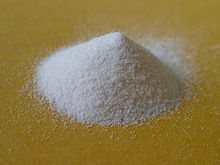Manganese(II) sulfate
 Manganese(II) sulfate monohydrate
| |
 Manganese(II) sulfate tetrahydrate
| |
| Names | |
|---|---|
| IUPAC name
Manganese(II) sulfate
| |
| Identifiers | |
| |
3D model (JSmol)
|
|
| ChEMBL | |
| ChemSpider | |
| ECHA InfoCard | 100.029.172 |
| EC Number |
|
PubChem CID
|
|
| RTECS number |
|
| UNII | |
CompTox Dashboard (EPA)
|
|
| |
| |
| Properties | |
| MnSO4 | |
| Molar mass | 151.001 g/mol (anhydrous) 169.02 g/mol (monohydrate) 223.07 g/mol (tetrahydrate) 277.11 g/mol (heptahydrate) |
| Appearance | white crystals (anhydrous) pale pink solid (hydrates) |
| Density | 3.25 g/cm 3 (anhydrous) 2.95 g/cm3 (monohydrate) 2.107 g/cm3 (tetrahydrate) |
| Melting point | 710 °C (1,310 °F; 983 K) (anhydrous) 27 °C (tetrahydrate) |
| Boiling point | 850 °C (1,560 °F; 1,120 K) (anhydrous) |
| 52 g/100 mL (5 °C) 70 g/100 mL (7 °C) | |
| Solubility | soluble in alcohol insoluble in ether |
| Structure | |
| orthogonal (anhydrous) monoclinic (monohydrate) monoclinic (tetrahydrate) | |
| Hazards | |
| NFPA 704 (fire diamond) | |
| Safety data sheet (SDS) | ICSC 0290 |
| Related compounds | |
Other cations
|
Chromium(III) sulfate Iron(II) sulfate |
Except where otherwise noted, data are given for materials in their standard state (at 25 °C [77 °F], 100 kPa).
| |
Manganese(II) sulfate usually refers to the inorganic compound with the formula MnSO4·H2O. This pale pink deliquescent solid is a commercially significant manganese(II) salt. Approximately 260 thousand tonnes of manganese(II) sulfate were produced worldwide in 2005. It is the precursor to manganese metal and many other chemical compounds. Mn-deficient soil is remediated with this salt.[1]
Structure
Like many metal sulfates, manganese sulfate forms a variety of hydrates: monohydrate, tetrahydrate, pentahydrate, and heptahydrate. The monohydrate is most common. All of these salts dissolve to give faintly pink solutions of the aquo complex [Mn(H2O)6]2+. The pale pink colour of Mn(II) salts is highly characteristic.
Applications and production
Typically, manganese ores are purified by their conversion to manganese(II) sulfate. Treatment of aqueous solutions of the sulfate with sodium carbonate leads to precipitation of manganese carbonate, which can be calcined to give the oxides MnOx. In the laboratory, manganese sulfate can be made by treating manganese dioxide with sulfur dioxide:[2]
- MnO2 + SO2 → MnSO4
It can also be made by mixing potassium permanganate with sodium hydrogen sulfate and hydrogen peroxide.
Manganese sulfate is a by-product of various industrially significant oxidations that use manganese dioxide, including the manufacture of hydroquinone and anisaldehyde.[1]
Electrolysis of manganese sulfate yields manganese dioxide, which is called EMD for electrolytic manganese dioxide. Alternatively oxidation of manganese sulfate with potassium permanganate yields the so-called chemical manganese dioxide (CMD). These materials, especially EMD, are used in dry-cell batteries.[1]
References
- ^ a b c Arno H. Reidies "Manganese Compounds" Ullmann's Encyclopedia of Chemical Technology 2007; Wiley-VCH, Weinheim. doi:10.1002/14356007.a16_123
- ^ John R. Ruhoff (1943). "n-Heptanoic acid". Organic Syntheses; Collected Volumes, vol. 2, p. 315.

